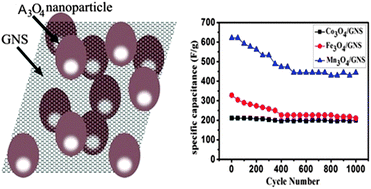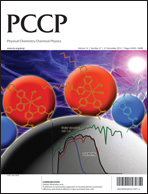Transition metal oxide and graphene nanocomposites for high-performance electrochemical capacitors†
Abstract
A method for producing nanocomposites of transition metal oxides A3O4 (where A represents Mn, Fe or Co) and graphene nanosheets (GNS) is presented. The reduction of graphene oxide (GO) and the formation of A3O4 nanoparticles (NPs) were carried out simultaneously during the reaction. The electrochemical properties of A3O4–GNS nanocomposites as electrode materials for supercapacitors are investigated by cyclic voltammetry and galvanostatic charge–discharge tests. The as-prepared Mn3O4–GNS, Fe3O4–GNS and Co3O4–GNS nanocomposites exhibit large specific capacitance (708, 358 and 240 F g−1, respectively), high energy density (20, 10 and 7 W h kg−1, respectively) and good electrochemical stability (retention of 73%, 67.8% and 95.8%, respectively, after 1000 charge–discharge cycles). The excellent electrochemical performance of the A3O4–graphene nanocomposites indicates great potential in the application in commercial supercapacitors.


 Please wait while we load your content...
Please wait while we load your content...